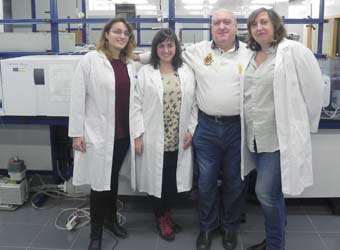
It is possible to measure alcohol consumption of a certain population by the presence in wastewater of a stable metabolite: ethyl sulfate, excreted in urine. A work in which Universitat de València has taken part, referred to Fallas period, confirms that alcohol consumption increments a 400% on average during the last three days, and that on 19 March, ‘Cremà’ day, it reaches its peak of up to six times higher than the usual values.
‘During Fallas week acohol consumption in the metropolitan area of Valencia increments approximately an amount two beers per person on avarage in the 15-65 age range’ according to Yolanda Picó, full university professor from the Departament of Preventive Medicine and Public Health of the Faculty of Pharmacy of Universitat de València.
The results of the research, ‘Estimation of alcohol consumption during “Fallas” festivity in the wastewater of Valencia city (Spain) using ethyl sulfate as a biomarker’, show that the average alcohol consumption goes from the 15 millilitres per person and day, considering weekends, to 55 ml/person/day during Fallas, this is to say, ‘the alcohol consumption is four times higher’, in the words of the Universitat researcher. The peak day, 19 March or ‘la Nit de la Cremà’ and the ending of Fallas, alcohol consumption increments up to 600%
The review that points out these conclusions was carried out by taking samples of wastewater every day from the 7th to the 20th of March of 2014 coming from three wastewater plants in the metropolitan area of Valencia: Pinedo I, Pinedo II and Quart-Benàger
It was possible to determinate the presence of the amount of alcohol due to the presence of ethyl sulfate. Once the alcohol is ingested, it is broken down, among others, to two metabolites that are excreted in urine: ethyl sulfate and ethyl glucuronide. The first one is established in water and, therefore, is a good biomarker to determinate alcohol consumption from its presence in watewater.
The amount of this compound was determined by injecting wastewater straightaway with an electron pair in a liquid chromatograph with a mass spectrometer. The electron pair is used to determinate compounds that are found ionized in the samples, this is to say, with electronic charge, in this case, negative. It consists in adding a counter ion (a molecula that has an opposite electric charge, positive in this case, and it has to be also of a large size). Thus, the ethyl sulfate negative charge is counteracted by the positive charge of the counter ion and they form a neutral basis, that is easier to analyse.
The liquid chromatography is a technique that separtes molecules depending on its polarity. It works really well with medium polarity molecules that are not ionized in solution (therefore the ion pair is used). Furthermore, the mass spectrum detects the molecule and it also provides information about its structure. This method ionizes and partially fragments molecules and, afterwards, it divides the ions depending on its mass/charge (m/Q), and that is how an imprint or characteristic pattern is obtained.
In this way, it has been measured the most typical drinks that are usually consumed and the quantity, and the amount of ethanol has been calculated. Like that, the regular alcohol consumption shows that the most consumed drink is beer (50%), high-proof alcohol (28%), wine (20%) and others (2%). To the three first ones it belongs, respectively, a 5, 40, and 12%. The regular volume of consumption of these drinks is of 250 ml of beer; 30 ml of high-proof alcohol and 125 ml of wine. These numbers provide, respectively, 12.5;12 and 15 milliliters of pure ethanol. With these numbers, and the measurements in the wastewater plants, the research team has been able to estimate the amount of these drinks that has been consumed.
The work, ‘Estimation of alcohol consumption during “Fallas” festivity in the
wastewater of Valencia city (Spain) using ethyl sulfate as a biomarker’ has been published in ‘Science of The Total Environment’ in the last quarter of 2015. Its authors are María Jesús Andrés-Costa, Úrsula Escrivá, Vicente Andreu and Yolanda Picó. The research has been financed by the Ministry of Economy and Competitiveness.
Results in real time
Unlike other methods, with this one it is possible to obtain reults practically in real time and even to discover where consumption points can be dangerous for health, in Picó’s words: ‘Usually, alcohol consumption is established by following sales data, but in this way consumption in a particular event or during holiday periods cannot be evaluated, since these potential consumption peaks become blurred in annual data’
Differences depending on the area
The research also verifies the differences between days in the period analysed. Therefore, form the 4 to the 14 March it is considered as a normal work perid, whereas from the 15 to the 20 March it is considerded as a holiday period and, consequently, exceptional regarding alchol consumption. The results of the whole interval agree globaly on the analysed numbers and are examined in analysis in Santiago de Compostela, Oslo or Barcelona.
Furthermore, in the particular case of Quart-Benàger wastewater plant, located in an industrial area where the population decreases significantlly during the weekends, it has been observed that from the 15 to the 20 (from Saturday to Thursday) there is a significant increase in alcohol consumption in the weekdays with regard to usual consumption, and it is the wastewater plant where the highest rates of alcohol consumption are registered.
Research article
María Jesús Andrés-Costa, Úrsula Escrivá, Vicente Andreu, Yolanda Picó: The work, ‘Estimation of alcohol consumption during “Fallas” festivity in the
Science of the Total Environment. Volume 541, 15 January 2016, page. 616–622. Doi: 10.1016/j.scitotenv.2015.09.126
Article link: http://www.sciencedirect.com/science/article/pii/S0048969715307877
Last update: 4 de february de 2016 07:00.
News release



















